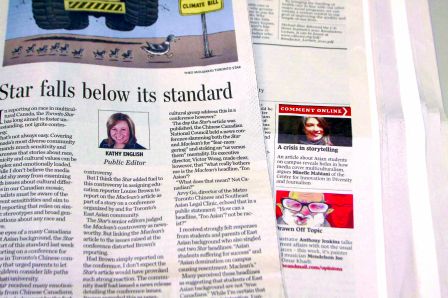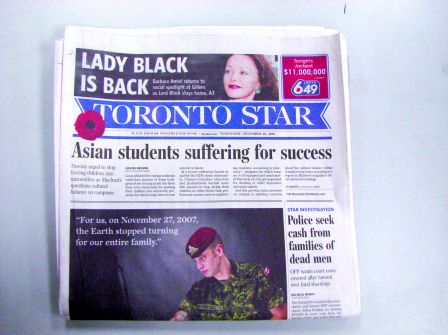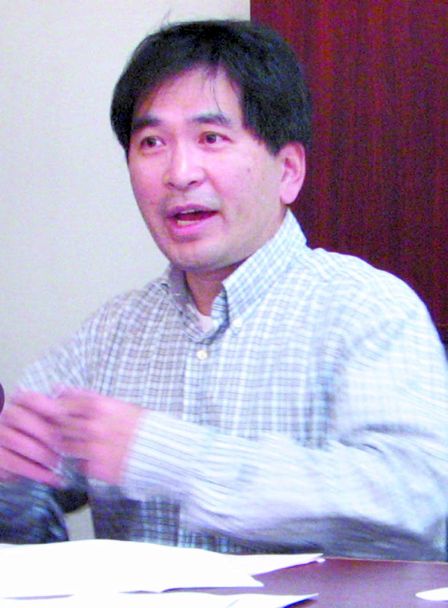-监察员社论版撰文承认 “亚裔生被迫入大学”《星报》报道未达标准
-文章被指解释立场非道歉
-Star falls below its standard

20日,《星报》在社论版刊登了以《星报未能达到标准》为题、由该报独立监察员英格利希撰写的文章。(《明报》∕区玉瑜 摄)

《多伦多星报》在10日发表的一篇名为《亚裔学生被迫入大学》的报道。(《明报》)
监察员社论版撰文承认 “亚裔生被迫入大学”《星报》报道未达标准
明报/针对《多伦多星报》(Toronto Star)在本月10日发表的一篇名为“亚裔学生被迫入大学”的报道,该报在昨天的社论版上刊登了由该报独立监察员英格利希(Kathy English)撰写的一篇文章,承认该报将有关“条条大路、成功之道”研讨会的报道与《麦克琳》(Maclean’s)杂志颇具争议性的报道融为一体,在处理新闻的敏感性方面未能达到该报的标准。
加国时事周刊《麦克琳》杂志和《多伦多星报》,曾在本月10日分别发表了题为大学“太亚洲化?”(Too Asian?)以及“亚裔学生被迫入大学∶据《麦克琳》报道”的文章,在加拿大的华人社区内掀起了轩然大波,招徕多个社区团体和众多华裔加人的猛烈抨击,并敦促上述两份报刊公开作出道歉。
对此,《多伦多星报》在昨天的社论版上刊登了一篇以《星报未能达到标准》(Star falls below its standard)为题的文章,其作者就是该报的独立监察员(Public Editor)英格利希。
英格利希在文章的开头这样写到:“在多元文化的加拿大,《星报》在报道涉及种族的新闻时,长期以来的目标就是促进了解,而不是引发争议。
然而,要做到上述这点并不容易。报道加拿大最多元化的族裔社区,要求有更高的敏感度和警觉度。而涉及种族和文化价值等方面的新闻报道,可以是复杂和充满情绪化的。
不过,我并不认为传媒应该回避有关文化差异的尖锐议题,新闻工作者必须有与生俱来的敏感性,并且致力于避免报道那些与种族和文化有关、仅仅基于过于简单化的种族定型的新闻。”
紧接着,她又写到:“在很多拥有东亚裔背景的加拿大人眼中,《星报》上周在报道多伦多华人社区举办的一个研讨会时,未能达到上述标准。”
英格利希在文章中坦言,《星报》在上述报道发表后,收到了很多华裔加拿大人的电邮,令他们特别感到不满的是,上述报道与《麦克琳》杂志颇具争议性的报道联系在一起。
她指出,尽管加拿大的新闻工作者均非常明白,《麦克琳》以大学“太亚洲化?”为题的报道势必引发争议,但在她看来,《星报》派出教育记者布朗(Louise Brown)在报道华人社区的一个研讨会时,又报道《麦克琳》的争议文章,确实是火上浇油。
她解释说:“根据《星报》资深编辑的判断,《麦克琳》的争议文章具有新闻价值。但是,将该篇文章与(华人社区)研讨会所探讨的议题联系在一起,歪曲了布朗的报道。如果布朗仅就是次研讨会进行报道,预期不会引发如此强烈的反响。”
英格利希还在文章中引用了全加平权会总干事黄煜文、法律援助中心(服务华人和东南亚社区)行政主任吴瑶瑶所发表的言论,亦列举了多名华裔读者情绪激动的批评意见。
她在文章的结尾总结说:“我认为给《星报》的报道贴上‘鞭打亚裔’的标签是过分的。但是,将《星报》的报道与《麦克琳》的争议文章融为一体,《星报》在处理新闻的敏感性方面未能达到标准。”
文章被指解释立场非道歉

明报/全加平权会总干事黄煜文(图)昨天指出,尽管《多伦多星报》的独立监察员英格利希(Kathy English)昨天在该报社论版上发表的文章,反映该报已“迈出了正面的一小步”,但她在文中不断谴责《麦克琳》杂志,没有将重点放在《星报》应该如何承担责任方面。
黄煜文昨天在接受本报采访时指出,《星报》在其社论版上刊登英格利希的文章,说明该报已就引发争议的报道进行了严肃的思考,可以说是“迈出了正面的一小步”。而英格利希在撰写此文之前,曾在本周三晚采访了他,她的态度亦是相当正面的。
然而,英格利希在上述文章中并未提及一些事实,例如:《星报》记者布朗实际上并未亲自出席由“燃动青年”(Across U-hub)举办的“条条大路、成功之道”研讨会,她只是根据是次研讨会的新闻稿做了一个跟进报道。
黄煜文说,“燃动青年”举办上述研讨会是做了一件好事,但《星报》的报道指只有亚裔家长强迫子女读大学,这是很不公平的。如果该篇报道是关于家长的,那么为何没有涉及白人家长、犹太人家长、黑人家长等其他不同族裔的家长?
他还表示,英格利希在文章结尾的最后两句话,令他感到很有问题。
他尖锐地说:“她在文章中不断谴责《麦克琳》杂志,她应该将重点放在《星报》上,因为《星报》必须承担自己的责任。”
他又说:“尽管她的文章有道歉的语气,但不是道歉,这可能令有些人会感到更加不满。”
黄煜文告诉记者,全加平权会计划在明天(周一)召开新闻会,向公众汇报事件的进展。
社区活跃人士、人头税苦主后人李百良认为,英格利希的文章只不过在解释《星报》的立场,与华人社区敦促该报作出公开道歉的要求相距甚远。
他指出,《星报》的报道已在全加各地引起广大公众的强烈不满,与人头税这一议题相比,该报道所涉及的“种族定型”的问题更大。
对此,来自加国各地的多个社区组织、学生团体和个人等正在组织一个联盟,以加拿大人的身分携手合作,联合起来向种族歧视宣战。上述联盟中包括了多伦多大学学生会、卑诗大学学生会和怀雅逊大学学生会等。
多伦多大学社会系副教授Roland Coloma向本报透露,该校学生将针对“多伦多大学是否太亚洲化”等颇具争议性的议题,在本月29日举办宣讲会。
据悉,维多利亚大学的学生将会发起杯葛《麦克琳》杂志以及《多伦多星报》的行动,藉此敦促这两份报刊作出公开的道歉。
English: Star falls below its standard
Published On Sat Nov 20 2010
By Kathy English, Public Editor
In reporting on race in multicultural Canada, the Toronto Star has long aimed to foster understanding, not ignite controversy.
That’s not always easy. Covering Canada’s most diverse community demands much sensitivity and awareness that stories about race, ethnicity and cultural values can be complex and emotionally loaded.
While I don’t believe the media should shy away from examining tough issues about cultural differences in our Canadian mosaic, journalists must be aware of the inherent sensitivities and aim to avoid reporting that relies on simplistic stereotypes and broad generalizations about any race and culture.
In the eyes of a many Canadians of East Asian background, the Star fell short of this standard last week in reporting on a conference for families in Toronto’s Chinese community that urged parents to let their children consider life paths other than university.
The Star received many emotional emails from Chinese Canadians, most particularly upset by the fact that our Page 1 story connected the concerns raised at that conference to a controversial article titled “ ‘Too Asian’?” published in the latest Maclean’s magazine university guide.
The magazine quoted some anonymous privileged white kids’ view that some Canadian universities have a large Asian student body, reporting that “some frosh don’t want to study at an ‘Asian’ university.” The article states that an “Asian” school “has come to mean one that is so academically focused that some students feel they can no longer compete or have fun.”
It’s not my role to criticize or defend the journalism of other news organizations or speculate on the reasons Maclean’s had for publishing this article. I do expect that Canadian journalists would well understand that the headline “ ‘Too Asian’?” — even framed as a question — would certainly spark controversy.
But I think the Star added fuel to this controversy in assigning education reporter Louise Brown to report on the Maclean’s article as part of a story on a conference organized by and for Toronto’s East Asian community.
The Star’s senior editors judged the Maclean’s controversy as newsworthy. But linking the Maclean’s article to the issues raised at the conference distorted Brown’s reporting.
Had Brown simply reported on the conference, I don’t expect the Star’s article would have provoked such strong reaction. The community itself had issued a news release detailing the conference issues. Brown regarded this as newsworthy because it addressed the East Asian community’s own concerns about pushing their children to succeed at university.
Brown has written often and with much sensitivity about the “achievement gap” between various races and ethnic groups in Toronto schools, which is well-documented by demographic statistics now collected by the Toronto District School Board. Those statistics clearly tell us that students of East Asian background are significant leaders in earning good grades and gaining admittance to university.
“The conference caught my eye because it focused on parents and education. It’s true that a lot of parents of all backgrounds are obsessed by wanting their children to go to university and don’t let their kids consider other paths such as college.
“I’d never seen one particular cultural group address this in a conference however.”
The day the Star’s article was published, the Chinese Canadian National Council held a news conference slamming both the Star and Maclean’s for “fear-mongering” and stoking an “us versus them” mentality. Its executive director, Victor Wong, made clear, however, that “what really bothers me is the Maclean’s headline, ‘Too Asian’?
“What does that mean? Not Canadian?”
Avvy Go, director of the Metro Toronto Chinese and Southeast Asian Legal Clinic, echoed that in a public statement: “How can a headline, ‘Too Asian’? not be racist?”
I received strongly felt responses from students and parents of East Asian background who also singled out two Star headlines: “Asian students suffering for success” and “Asian domination on campus causing resentment: Maclean’s.”
Many perceived these headlines as suggesting that students of East Asian background are not “true Canadians.” While I’m certain that was not the Star’s intention, I understand the emotional reaction this provoked.
“The term ‘Asian’, within the context of the articles, is pejorative. It is used as a racial and ethnic epithet, and is offensive and prejudicial,” reader Chuang Lee said. “Without trying very hard, the Star and Maclean’s have unwittingly contributed to the staining of our Canadian multiracial and multicultural fabric.”
Reader Helen Lee went further than that in her criticism: “Climbing onto the Maclean’s bandwagon of Asian-bashing at this point of time in our Canadian history is so disappointing,” she said.
I think labeling the Star’s story as “Asian-bashing” goes too far. But, in melding our reporting with the Maclean’s controversy, the Star fell short of its usual standard of sensitivity.
http://www.thestar.com/opinion/publiceditor/article/894113–english-star-falls-below-its-standard


